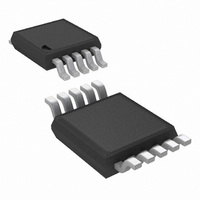LM25061PMM-2/NOPB National Semiconductor, LM25061PMM-2/NOPB Datasheet - Page 11

LM25061PMM-2/NOPB
Manufacturer Part Number
LM25061PMM-2/NOPB
Description
IC CTLR POS HOTSWAP AUTO 10MSOP
Manufacturer
National Semiconductor
Type
Hot-Swap Controllerr
Datasheet
1.LM25061PMME-2NOPB.pdf
(20 pages)
Specifications of LM25061PMM-2/NOPB
Applications
General Purpose
Internal Switch(s)
No
Voltage - Supply
2.9 V ~ 17 V
Operating Temperature
-40°C ~ 85°C
Mounting Type
Surface Mount
Package / Case
10-TFSOP, 10-MSOP (0.118", 3.00mm Width)
Lead Free Status / RoHS Status
Lead free / RoHS Compliant
Other names
LM25061PMM-2
Available stocks
Company
Part Number
Manufacturer
Quantity
Price
Company:
Part Number:
LM25061PMM-2/NOPB
Manufacturer:
NS
Quantity:
12 112
If the system input voltage falls below the UVLO threshold,
the GATE pin is pulled low by the 2 mA pull-down current to
switch off Q1.
Current Limit
The current limit threshold is reached when the voltage across
the sense resistor R
current limiting condition, the GATE voltage is controlled to
limit the current in MOSFET Q1. While the current limit circuit
is active, the fault timer is active as described in the Fault
Timer & Restart section. If the load current falls below the
current limit threshold before the end of the Fault Timeout
Period, the LM25061 resumes normal operation. For proper
operation, the R
mΩ. Higher values may result in instability in the current limit
control loop.
Circuit Breaker
If the load current increases rapidly (e.g., the load is short-
circuited) the current in the sense resistor (R
the current limit threshold before the current limit control loop
is able to respond. If the current exceeds approximately twice
the current limit threshold (95 mV/R
off by the 260 mA pull-down current at the GATE pin, and a
Fault Timeout Period begins. When the voltage across R
falls below 95 mV the 260 mA pull-down current at the GATE
pin is switched off, and the gate voltage of Q1 is then deter-
mined by the current limit or the power limit functions. If the
TIMER pin reaches 1.72V before the current limiting or power
limiting condition ceases, Q1 is switched off by the 2 mA pull-
down current at the GATE pin as described in the Fault Timer
& Restart section.
Power Limit
An important feature of the LM25061 is the MOSFET power
limiting. The Power Limit function can be used to maintain the
maximum power dissipation of MOSFET Q1 within the device
SOA rating. The LM25061 determines the power dissipation
in Q1 by monitoring its drain-source voltage (SENSE to OUT),
and the drain current through the sense resistor (VIN to
SENSE). The product of the current and voltage is compared
to the power limit threshold programmed by the resistor at the
PWR pin. If the power dissipation reaches the limiting thresh-
old, the GATE voltage is modulated to regulate the current in
Q1. While the power limiting circuit is active, the fault timer is
active as described in the Fault Timer & Restart section.
S
resistor value should be no larger than 200
S
(VIN to SENSE) reaches 50 mV. In the
S
), Q1 is quickly switched
S
) may exceed
S
11
Fault Timer & Restart
When the current limit or power limit threshold is reached
during turn-on or as a result of a fault condition, the gate-to-
source voltage of Q1 is modulated to regulate the load current
and power dissipation in Q1. When either limiting function is
activated, an 80 µA fault timer current source charges the ex-
ternal capacitor (C
(Fault Timeout Period). If the fault condition subsides during
the Fault Timeout Period before the TIMER pin reaches
1.72V, the LM25061 returns to the normal operating mode
and C
pin reaches 1.72V during the Fault Timeout Period, Q1 is
switched off by a 2 mA pull-down current at the GATE pin.
The subsequent restart procedure then depends on which
version of the LM25061 is in use.
The LM25061-1 latches the GATE pin low at the end of the
Fault Timeout Period. C
2.5 µA fault current sink. The GATE pin is held low by the 2
mA pull-down current until a power up sequence is externally
initiated by cycling the input voltage (V
pulling the UVLO pin below its threshold with an open-collec-
tor or open-drain device as shown in
the TIMER pin must be less than 0.3V for the restart proce-
dure to be effective.
The LM25061-2 provides an automatic restart sequence
which consists of the TIMER pin cycling between 1.72V and
1V seven times after the Fault Timeout Period, as shown in
Figure
charging current, and the 2.5 µA discharge current, and the
value of the capacitor C
during the eighth high-to-low ramp, the 20 µA current source
at the GATE pin turns on Q1. If the fault condition is still
present, the Fault Timeout Period and the restart cycle repeat.
The Fault Timeout Period during restart cycles is approxi-
mately 18% shorter than the initial fault timeout period which
initiated the restart cycle. This is due to the fact that the
TIMER pin transitions from 0.3V to 1.72V after each restart
time, rather than from ground.
T
5. The period of each cycle is determined by the 80 µA
is discharged by the 2.5 µA current sink. If the TIMER
FIGURE 4. Latched Fault Restart Control
T
) at the TIMER pin as shown in
T
T
. When the TIMER pin reaches 0.3V
is then discharged to ground by the
Figure
SYS
), or momentarily
4. The voltage at
www.national.com
Figure 5
30090315












